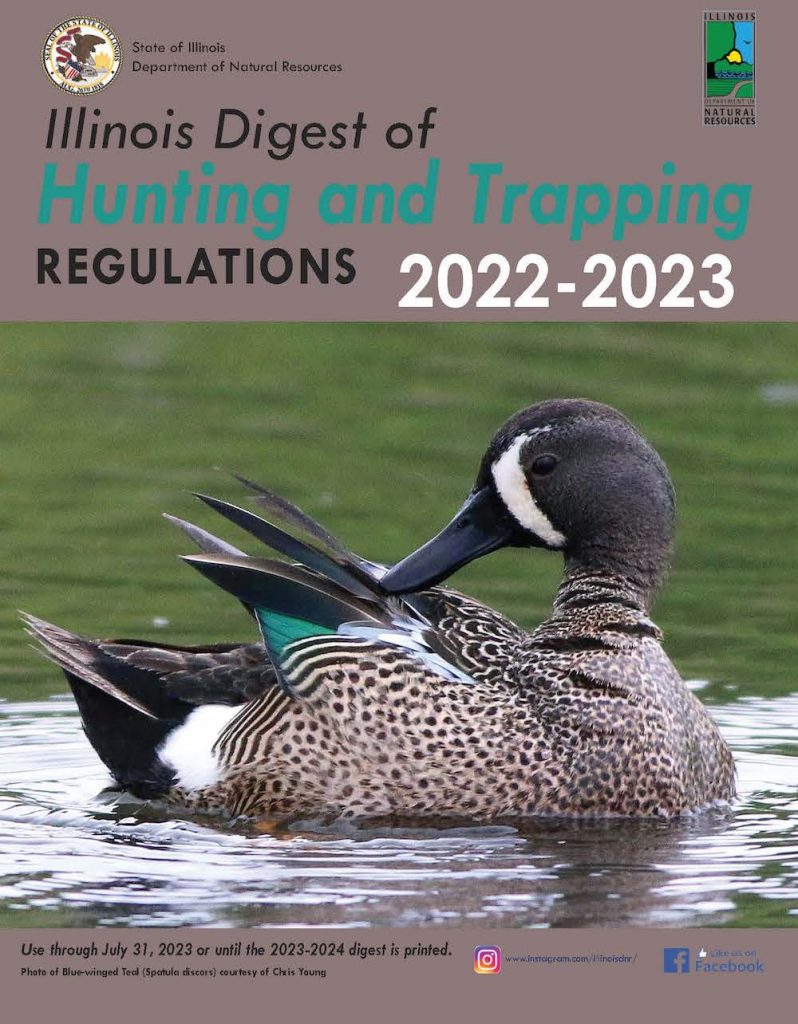
Photo by Michael R. Jeffords.



Photo by Michael R. Jeffords.
A preening blue-winged teal image taken by Illinois Department of Natural Resources (IDNR) Office Director Chris Young is featured on the cover of the 2022-2023 Illinois Hunting and Trapping Digest. Well known in the waterfowl hunting and birdwatching communities, the fast-flying blue-winged teal is known for its “kick, kick, kick, kick” call. A common migrant through Illinois, blue-winged teal remain to breed in the northern two-thirds of the state.
According to Joshua Osborn, Waterbird Ecologist with the Illinois Natural History Survey’s Frank C. Bellrose Waterfowl Research Center, complete aerial surveys of waterfowl breeding populations returned in 2022 after a hiatus due to the pandemic.

“In 2019, blue wings were hovering near the long-term average of 5.1 million in North America,” Osborn noted. “Surveys in recent years along the Illinois and central Mississippi rivers show a similar trend for Illinois.”
The average blue-wing teal peak over the last 10 years on the waterfowl survey has been approximately 35,000 birds, with the peak occurring between the first and the third weeks of September.
“The peak in the blue-wing population in Illinois has been coinciding with our September teal hunting season,” Osborn continued. “During the 2020-2021 hunting season, blue-winged teal were the second-most harvested (25,711) among duck species in Illinois, lagging only behind the harvest of mallards. The same trends hold for the 2019 hunting season, with 34,583 blue-winged teal harvested.”
Blue-winged teal usually are not included in the harvest rankings by species, often because the bulk of their harvest occurs during the September teal season. Other than other teal species (green-winged and cinnamon teal), no other species of duck is permitted to be harvested during this early season.
Kaleb Wood, Victoria Arterberry, and Nate Grider with the IDNR Division of Wildlife Resources coordinated preparation of this annual digest. Three key changes have been identified that hunters and trappers should note.
“Outdoor enthusiasts are asked to review three changes highlighted in the 2022-2023 Digest,” Arterberry, IDNR Office Coordinator, explained. One pertains to the ban on the use of drones when hunting mammals or birds, another change will allow use of a single shot certain centerfire rifles to hunt deer starting in 2023 and the third change pertains to hunting coyotes from tree stands.
The use of unmanned aircraft (drone) has been added to the list of vehicles and conveyances that are unlawful to use to take, pursue or intentionally harass or disturb in any manner any wild birds or mammals, except as permitted by the Code of Federal Regulations for the taking of waterfowl.
“Beginning in 2023, a single shot centerfire rifle may be used to hunt deer in Illinois,” explained Kaleb Wood, IDNR District Wildlife Biologist and Hunter Heritage Biologist. “This updated law means that beginning in 2023, deer hunters may use a shotgun, handgun, single shot centerfire rifle, muzzleloading rifle or bow and arrow.”

The regulations define “single shot” as a gun either manufactured or modified to only be capable of holding a total of one round in the magazine and chamber combined. The only legal ammunition for a centerfire handgun or rifle is a bottleneck centerfire cartridge of .30 caliber or larger, with a case length not exceeding one and two-fifths inches, or a straight-walled centerfire cartridge of .30 caliber or larger, both of which must be available as a factory load with the published ballistic tables of the manufacture showing a capability of at least 500 foot pounds of energy at the muzzle. Persons interested in utilizing a single shot centerfire rifle are advised to review the 2022-2023 Digest of Hunting and Trapping Regulations. Further information from the Illinois Department of Natural Resources will be forthcoming in early 2023.
“The final change of note is a legislative change requiring that during all deer seasons coyotes may only be taken from tree climbing devices [tree stands] by properly licensed deer hunters,” explained Division of Wildlife Resources Wildlife Programs Section Manager Nate Grider. “Starting with the fall 2022 seasons, during all deer seasons—archery, youth firearm, regular firearm, muzzleloader, CWD and late winter—hunters must have valid unfilled deer permits to hunt coyotes from trees.”
The Digest continues to be available in multiple formats, allowing outdoorsmen and women to access hunting and trapping information from a phone, tablet, computer or as a printed copy.
The 2022-2023 Digest and quick reference card also are available in Spanish and Polish.
Suggestions regarding the annual Digest are welcomed and may be emailed to DNR.Wildliferecep@Illinois.gov.
Kathy Andrews Wright retired from the Illinois Department of Natural Resources where she was editor of OutdoorIllinois magazine. She is currently the editor of OutdoorIllinois Journal.
Submit a question for the author
Question: Is it legal to use a drone to recover a dead deer. Drone Deer Recovery